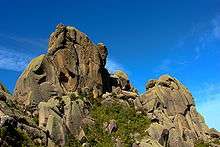Itatiaia National Park
Itatiaia Nacional Park is in Southeast Brazil at the border between Minas Gerais and Rio de Janeiro.
Get in
Itatiaia National Park (Parque Nacional do Itatiaia), established in 1937, is the oldest national park in Brazil.
It is on the border between Rio de Janeiro and Minas Gerais states, between 22º16’ - 22º28’ S and 44º34’ - 44º42’ W.
The park is part of the Mantiqueira mountain range, and home to Brazil's third highest mountain, Pico das Agulhas Negras, which stands at 2,878 m (9,442 ft). This peak is visible to the northwest of Resende when driving between São Paulo and Rio de Janeiro on the Via Dutra highway, which is the easiest route to get there.
The park attracts bird watchers from all over the world with its 250 species of birds. Other attractions include hiking and rock climbing.
The park is surrounded by the Mantiqueira Mountain Environmental Protection Area which provides an ecological buffer zone for the park.
The park is divided in two areas: high and low. The high area is accessible through an entrance about 35 km from the main entrance and gives access to the Pico das Agulhas Negras and Prateleiras complex. Josef Mengele lived in this area after World War II.
The low area of the park is much closer to the city of Itatiaia and has many waterfalls, such as Véu da Noiva with 45 m. The low area has also a Natural History museum.
Itatiaia means "many-pointed rock" in the Tupi language.
Fees and permits
Get around
See


Agulhas Negras and Prateleiras are the highest points in the park, and among the highest points in the whole country. The vegetation gets sparser the higher you go, so don't forget sunblock and a hat. The views are fabulous, especially in the dry season (May-Aug). Prateleiras is an easy climb but Agulhas Negras is a little tougher, and requires some effort, if not actual moutaineering skills. Due to an arson attack a few years ago, which resulted in a huge fire that destroyed most of the area's vegetation (it has since recovered), access is only possible with a registered guide or agency. These can be hired through the local pousadas (small hotels). Agencies usually provide their own 4x4 transport, probably the better option, because access is through a secondary gate very far from the main entrance and the access road is very rough.
- Agulhas Negras (Black Needles).
- Prateleiras.
- Véu de Noiva Waterfall.
Do
From its summit you can see across the region, such as the dam of the funnel, Sierra Fina, the region of Visconde de Mauá, the vast region of Vale do Paraíba, where are located the most populous cities in the axis of Brazil, the Rio-São Paulo, and Rio Paraiba, which causes the name of the valley. The region is highly sought by tourists seeking to stay in hotels near the park-farm during the winter and by adventurers who set up in camps close to the peak for the practice of sports such as mountaineering, trekking and rappelling the, what is known as adventure tourism.
Buy
Eat
Drink
Sleep
There are small hotels (pousadas) and one large hotel within the park. A good small one is Donati, (24) 33521110. Its fairly expensive, but the rate includes all meals, and it is situated in a forest clearing, which makes for unequaled access to the park itself 24 hours a day.
Apparently this is only national park in Brazil that has this kind of infrastructure within the park.
Lodging
Penedo, which lies at the foot of the Serra da Mantiqueira at an altitude of 600 m (2000 ft), is the best equipped tourist center in the region. Founded in 1929 by Finnish natural scientists, it lies within the commune of Itatiaia, 3 km (2 mi) north of the town and 170 km (106 mi) north-west of Rio de Janeiro.
Camping
Backcountry
Stay safe
Before visiting Itatiaia National Park read about it. Many books are available:
- Jorge Pádua, Maria Tereza e Coimbra Filho, Adelmar F. Os Parques Nacionais do Brasil. Instituto de Cooperação Iberoamericana. Madrid. José Olympio Editora, 1989. ISBN 8485389190, pág. 122 a 129
- Corrêa, Marcos Sá "Itatiaia - O Caminho das Pedras" São Paulo. Metalivros, 2003. ISBN 8585371501, 240 pág.
- Leite, Helton Perillo Ferreira - "Planalto do Itatiaia - Região das Agulhas Negras", Rio de Janeiro. Montanhar / Publit, 2007. Edição parcialmente trilíngue. ISBN 9788577730766, 232 páginas.